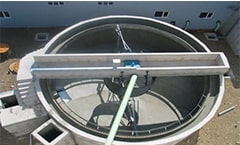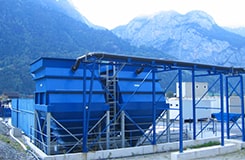
The process in which solids are separated from liquids is known as clarification. They are intended to create flocs from the suspended material in the wastewater by utilizing chemicals and let these flocs settle by gravity in calculated retention time. The selection of a tank configuration and collector mechanism as scraper type and/or suction type depends upon the characteristics of solids suspension of the process liquid. From Dutco Tennant you can get a complete range of settlement sewage tank clarifiers for wastewater treatment in rotating and traveling types.
The settling tanks, clarifiers are built with mechanical means for continuous removal of solids being deposited by sedimentation. A clarifier for wastewater treatment is mainly used for removing solid particulates or suspended solids from liquid for clarification and thickening. The concentrated impurities which are discharged from the bottom of the tanks are called sludge, while the particles which float to the surface of the liquid are known as scum. Sedimentation may occur in tanks of other shapes, but the removal of accumulated solids is much easier with conveyor belts in rectangular tanks or with scrapers rotating around the central axis of circular tanks. The mechanical solids removal devices move as slowly as practical to minimize resuspension of settled solids. To give optimal residence time to water within the tank, tanks are sized. It is economical to use small tanks, but if the flow rate through the clarifier tank in wastewater treatment is very high, most particles will not have sufficient time to settle and will be carried with the treated water. A high amount of attention is given to reducing water inlet and outlet velocities for minimizing turbulence and promotes effective settling throughout available tank volume. For preventing fluid velocities at the tank entrance from extending into the tank, baffles are used. Overflow weirs are used for uniformly distributing the flow from liquid leaving the tank over a wide area of the surface to minimize resuspension of settling particles.
For treating wastewater for a very long time, sedimentation tanks have been used. The primary treatment of sewage is the removal of floating and settleable solids via sedimentation. The primary clarifiers can reduce the content of suspended solids and pollutants embedded in those suspended solids. Due to a large amount of reagent necessary for treating domestic wastewater, preliminary chemical coagulation and flocculation are generally not used, remaining suspended solids being reduced by the following stages of the system. Coagulation and flocculation can also be used for building a compact treatment plant or for further polishing of the treated water. Sedimentation tanks which are called secondary clarifiers for removing flocs of biological growth created in some methods of secondary treatment including activated sludge, trickling filters and rotating biological contactors.
At the treatment plants, the wastewater which is arriving comprises of various solids which can be removed easily by wastewater treatment processes. For instance, the impurities can be paper, rags, wood, eggshells, food particles and others. For removing the solids the wastewater gets inside a building which is known as the headworks and passes via the large-sized screen filters that have removed this material. Then the solids are placed inside a dumpster and then taken to the landfill. The only byproduct of wastewater treatment that is not recycled is this. The wastewater gets inside two huge circular tanks from headworks that are known as primary clarifiers. Each of these tanks can have around 600,000 gallons of water. In here the wastewater gets slow down and stays in the tanks for a certain amount of time. This makes way for the suspended material in the wastewater to either float on the surface or sinks down to the bottom. Slowly over the floor and surface of the primary clarifier, large paddles are rotating that can remove these materials from the wastewater. Entering the two Secondary Clarifiers for wastewater treatment, the wastewater is still containing various microorganisms from the basins of aeration and has a murky and brown look. The secondary clarifiers are very much similar to the primary clarifiers. In the wastewater, the materials present will sink and float and this material is removed from the water by the rotating arms.

